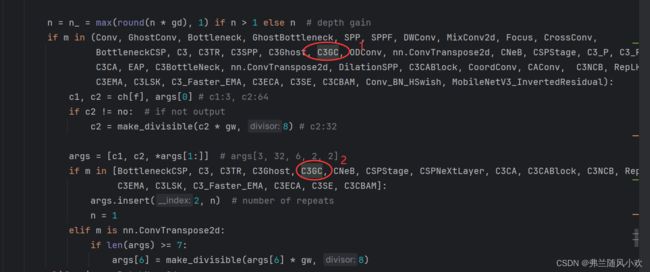【目标检测实验系列】YOLOv5创新点改进实验:融合Global Context Block全局注意力机制,增强Backbone的特征提取能力,模型高效涨点!(超详细改进代码流程)
1. 文章主要内容
本篇博客主要涉及两个主体内容。第一个:简单介绍Global Context Block的原理。第二个:基于YOLOv5 6.x版本,与Backbone部分的C3结构进行融合,提出一种新的结构C3GC(通读本篇博客需要10分钟左右的时间)。
这些点子都可以用来作为写SCI四区、北大核心论文的一个小创新点!
2. Global Context Block(原理:简单介绍,可自行详细研究)
2.1 Global Context Block
Global Context Block来源于GCNet论文,其主要的原理是通过non-local这种全局自注意力方法进行建模,让模型能够提取到全局上下文的关系(也可以说是特征),这样便可以增强模型提取特征的能力。另外,Global Context Block通过结合SENet的结构,使其模型的计算量得到很大的减少,使得其变为一个几乎没有消耗的即插即用模块。一般来说,YOLOv5的Backbone部分是用来提前数据的特征,尤其是浅层的特征。而浅层容易忽略的特征容易在网络结构比较深的时候难以提取,这个时候我们将Global Context Block与Backbone的C3结构进行融合,提出一种新的提取特征结构C3GC,这样通过全局建模关系,能够使得有用的特征更容易提取,于是模型提点也是显而易见的了。
原论文地址:GCNet原论文
2.2 博主数据集实验效果
博主所训练的数据集特点:小尺寸目标居多,密集且目标尺寸不一,实验数据如下所示:
原YOLOv5s框架实验数据:P(查准率):0.935、R(召回率):0.927、[email protected](平均检测精度):0.942
YOLOv5s+C3GC(Backbone四个C3都替换为C3GC):P(查准率):0.960、R(召回率):0.933、[email protected](平均检测精度):0.952
由实验数据对比,YOLOv5s+GC能够极大的提升P,同时R、mAP也有所提升,提升P指标,就表明检测精度更高,FLOPs较原YOLOv5增加了0.3,几乎无消耗。
3. 实验流程
3.1 C3GC结构
注意到:这里将GC(Global Context Block)分别融合到C3的两个分支当中(当然,也可以融合到任何一个分支当中,这个可以自行实验)。
3.2 代码详细改进流程(重要!!!)
3.1 新建C3GC.py文件
( 注意:博主使用的是Pycharm集成开发工具)首先在data->tricks目录下新建一个叫C3GC的py文件( 注意:tricks文件夹是自定义创建的,没有自己创建一个即可),将如下代码复制到C3GC的py文件中:
import torch
import torch.nn as nn
from models.common import Bottleneck
def autopad(k, p=None): # kernel, padding
# Pad to 'same'
if p is None:
p = k // 2 if isinstance(k, int) else [x // 2 for x in k] # auto-pad
return p
class Conv(nn.Module):
# Standard convolution
def __init__(self, c1, c2, k=1, s=1, p=None, g=1, act=True): # ch_in, ch_out, kernel, stride, padding, groups
super().__init__()
self.conv = nn.Conv2d(c1, c2, k, s, autopad(k, p), groups=g, bias=False)
self.bn = nn.BatchNorm2d(c2)
self.act = nn.SiLU() if act is True else (act if isinstance(act, nn.Module) else nn.Identity())
def forward(self, x):
return self.act(self.bn(self.conv(x)))
def forward_fuse(self, x):
return self.act(self.conv(x))
def constant_init(module, val, bias=0):
if hasattr(module, 'weight') and module.weight is not None:
nn.init.constant_(module.weight, val)
if hasattr(module, 'bias') and module.bias is not None:
nn.init.constant_(module.bias, bias)
def kaiming_init(module,
a=0,
mode='fan_out',
nonlinearity='relu',
bias=0,
distribution='normal'):
assert distribution in ['uniform', 'normal']
if hasattr(module, 'weight') and module.weight is not None:
if distribution == 'uniform':
nn.init.kaiming_uniform_(
module.weight, a=a, mode=mode, nonlinearity=nonlinearity)
else:
nn.init.kaiming_normal_(
module.weight, a=a, mode=mode, nonlinearity=nonlinearity)
if hasattr(module, 'bias') and module.bias is not None:
nn.init.constant_(module.bias, bias)
def last_zero_init(m):
if isinstance(m, nn.Sequential):
constant_init(m[-1], val=0)
m[-1].inited = True
else:
constant_init(m, val=0)
m.inited = True
class CB2d(nn.Module):
def __init__(self, inplanes, pool='att', fusions=['channel_add', 'channel_mul']):
super(CB2d, self).__init__()
assert pool in ['avg', 'att']
assert all([f in ['channel_add', 'channel_mul'] for f in fusions])
assert len(fusions) > 0, 'at least one fusion should be used'
self.inplanes = inplanes
self.planes = inplanes // 4
self.pool = pool
self.fusions = fusions
if 'att' in pool:
self.conv_mask = nn.Conv2d(inplanes, 1, kernel_size=1)
self.softmax = nn.Softmax(dim=2)
else:
self.avg_pool = nn.AdaptiveAvgPool2d(1)
if 'channel_add' in fusions:
self.channel_add_conv = nn.Sequential(
nn.Conv2d(self.inplanes, self.planes, kernel_size=1),
nn.LayerNorm([self.planes, 1, 1]),
nn.ReLU(inplace=True),
nn.Conv2d(self.planes, self.inplanes, kernel_size=1)
)
else:
self.channel_add_conv = None
if 'channel_mul' in fusions:
self.channel_mul_conv = nn.Sequential(
nn.Conv2d(self.inplanes, self.planes, kernel_size=1),
nn.LayerNorm([self.planes, 1, 1]),
nn.ReLU(inplace=True),
nn.Conv2d(self.planes, self.inplanes, kernel_size=1)
)
else:
self.channel_mul_conv = None
self.reset_parameters()
def reset_parameters(self):
if self.pool == 'att':
kaiming_init(self.conv_mask, mode='fan_in')
self.conv_mask.inited = True
if self.channel_add_conv is not None:
last_zero_init(self.channel_add_conv)
if self.channel_mul_conv is not None:
last_zero_init(self.channel_mul_conv)
def spatial_pool(self, x):
batch, channel, height, width = x.size()
if self.pool == 'att': # iscyy
input_x = x
input_x = input_x.view(batch, channel, height * width)
input_x = input_x.unsqueeze(1)
context_mask = self.conv_mask(x)
context_mask = context_mask.view(batch, 1, height * width)
context_mask = self.softmax(context_mask)
context_mask = context_mask.unsqueeze(3)
context = torch.matmul(input_x, context_mask)
context = context.view(batch, channel, 1, 1)
else:
context = self.avg_pool(x)
return context
def forward(self, x):
context = self.spatial_pool(x)
if self.channel_mul_conv is not None:
channel_mul_term = torch.sigmoid(self.channel_mul_conv(context))
out = x * channel_mul_term
else:
out = x
if self.channel_add_conv is not None:
channel_add_term = self.channel_add_conv(context)
out = out + channel_add_term
return out
class C3GC(nn.Module):
def __init__(self, c1, c2, n=1, shortcut=True, g=1,
e=0.5): # ch_in, ch_out, number, shortcut, groups, expansion #iscyy
super(C3GC, self).__init__()
c_ = int(c2 * e) # hidden channels
self.gc = CB2d(c1)
self.cv1 = Conv(c1, c_, 1, 1)
self.cv2 = Conv(c1, c_, 1, 1)
self.cv3 = Conv(2 * c_, c2, 1) # act=FReLU(c2)
# self.m = nn.Sequential(*[CB2d(c_) for _ in range(n)])
self.m = nn.Sequential(*[Bottleneck(c_, c_, shortcut, g, e=1.0) for _ in range(n)])
def forward(self, x):
out = torch.cat((self.m(self.cv1(self.gc(x))), self.cv2(self.gc(x))), dim=1)
out = self.cv3(out)
return out
class GCBottleneck(nn.Module):
# Standard bottleneck
def __init__(self, c1, c2, shortcut=True, g=1, e=0.5): # ch_in, ch_out, shortcut, groups, expansion
super().__init__()
c_ = int(c2 * e) # hidden channels
self.cv1 = Conv(c1, c_, 1, 1)
self.gc = CB2d(c1)
self.cv2 = Conv(c_, c2, 3, 1, g=g)
self.add = shortcut and c1 == c2
def forward(self, x):
return x + self.cv2(self.gc(self.cv1(x))) if self.add else self.cv2(self.gc(self.cv1(x)))
# 注意到这里的self.gc有两个,就分别对应于C3GC结构图的两个分支,如果想要只融合一个分支便删掉一个self.gc即可。
另外项目的data-tricks目录结构如下所示:( 之所以要新建文件,是为了方便,清晰的分辨哪些创新点,而不是一股脑都放在一个文件中)

3.2 创建一个yolov5s-gc.yaml文件
本实验以yolov5s作为基础模型,其他的YOLOv5模型类似。需要注意到,新建的文件一般存放于models文件夹下,另外需要修改文件中的nc(即为类别数目,根据自己的数据集来),其代码如下所示:
# YOLOv5 by Ultralytics, GPL-3.0 license
# Parameters
nc: 4 # number of classes
depth_multiple: 0.33 # model depth multiple
width_multiple: 0.50 # layer channel multiple
anchors:
- [10,13, 16,30, 33,23] # P3/8 小目标
- [30,61, 62,45, 59,119] # P4/16 中目标
- [116,90, 156,198, 373,326] # P5/32 大目标
# YOLOv5 v6.0 backbone
backbone:
# [from, number, module, args]
[[-1, 1, Conv, [64, 6, 2, 2]], # 0-P1/2 output_channel, kernel_size, stride, padding
[-1, 1, Conv, [128, 3, 2]], # 1-P2/4
[-1, 3, C3GC, [128]],
[-1, 1, Conv, [256, 3, 2]], # 3-P3/8
[-1, 6, C3GC, [256]],
[-1, 1, Conv, [512, 3, 2]], # 5-P4/16
[-1, 9, C3GC, [512]],
[-1, 1, Conv, [1024, 3, 2]], # 7-P5/32
[-1, 3, C3GC, [1024]],
[-1, 1, SPPF, [1024, 5]], # 9
]
# YOLOv5 v6.0 head
head:
[[-1, 1, Conv, [512, 1, 1]],
[-1, 1, nn.Upsample, [None, 2, 'nearest']],
[[-1, 6], 1, Concat, [1]], # cat backbone P4
[-1, 3, C3, [512, False]], # 13
[-1, 1, Conv, [256, 1, 1]],
[-1, 1, nn.Upsample, [None, 2, 'nearest']],
[[-1, 4], 1, Concat, [1]], # cat backbone P3
[-1, 3, C3, [256, False]], # 17 (P3/8-small)
[-1, 1, Conv, [256, 3, 2]],
[[-1, 14], 1, Concat, [1]], # cat head P4
[-1, 3, C3, [512, False]], # 20 (P4/16-medium)
[-1, 1, Conv, [512, 3, 2]],
[[-1, 10], 1, Concat, [1]], # cat head P5
[-1, 3, C3, [1024, False]], # 23 (P5/32-large)
[[17, 20, 23], 1, Detect, [nc, anchors]], # Detect(P3, P4, P5)
]
注意到,这里是使用四个C3GC替换了原本的C3结构,具体替换多少,可以自行尝试。
3.3 在yolo.py文件中引入C3GC
在models文件夹下的yolo.py文件如下图的位置中,引入C3GC并在头文件部分主动添加如下引入代码。
在yolo.py最上面添加如下代码:
from data.tricks.C3GC import C3GC
然后将C3GC添加到yolo.py文件中如图所示的位置,一共是两个地方:

3.4 在train.py文件中修改配置文件
在train.py文件中将配置文件修改为yolov5s-gc.yaml,如下图所示:

4. 本篇小结
本篇博客主要介绍了C3GC+YOLOv5的修改详细流程,助力模型高效涨点。另外,在修改过程中,要是有任何问题,评论区交流;如果博客对您有帮助,请帮忙点个赞,收藏一下;后续会持续更新本人实验当中觉得有用的点子,如果很感兴趣的话,可以关注一下,谢谢大家啦!